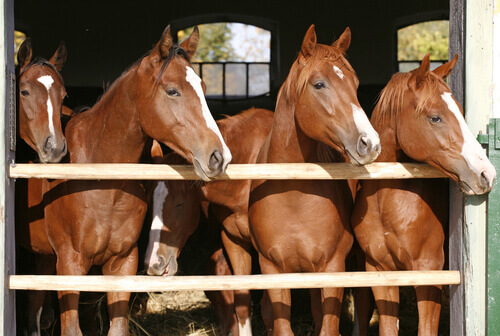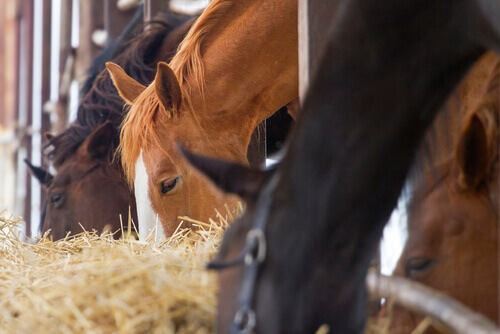Most Common Behavioral Problems in Horses


Written and verified by the lawyer Francisco María García
Horses in captivity may develop behavioral problems that aren’t considered normal in their daily routine. Most of them are victims of stables vices or compulsive behaviors, as a result of hyperactivity disorders due to confinement. The reason for these behavioral problems in horses is due to alterations in their way of life or in their habitat.
There are three basic conditions that maintain a horse’s physical and emotional balance. These are feeding, interaction with other horses, and freedom of movement. Therefore, the alteration in any or all of them can cause inadequate behavior in horses.
Thus, to minimize the effects of behavior problems in horses, specialists recommend different techniques, from environmental improvements, to pharmacological treatments. The application of any of them will depend on a previous diagnosis of the horse’s health.
Behavioral problems in horses
Behavioral problems in horses can occur due to internal or external factors. Among the former are pain and fear, either learned or induced. In the latter, the external ones, are the elements which a horse in confinement is subjected to.
Generally, horses are raised freely in open areas. They’re used to grazing, living in herds, and running long distances whenever they feel like it. The change in these routines due to their domestication is a source of stress, a situation that the animal doesn’t know how to handle.

The most common behavioral problems in horses are stable vices, eating disorders, and aggressive reactions. Stable vices are erratic behavior patterns that horses in confinement develop. This type of behavior increases the levels of endorphins and helps the horse minimize their stress.
Causes of behavioral problems in horses
- Diet. In general, a free horse grazes for 18 hours, searching for food and moving around.
- In confinement, a horse doesn’t have the freedom to maintain its routine or control its food intake. This situation causes, in most cases, high levels of anxiety, stress and depression, even other diseases.
- Pain or health problems. Pain is one of the main reasons why a horse may turn aggressive. Thus, it can express its aggressiveness towards other animals of the same species or even towards its trainer. So, this reaction is directly related to its internal condition.
- Alteration of their habitat. A domesticated horse can spend up to 22 hours a day inside its stall, without enough space to run, and isolated from other horses. This situation triggers depression and anxiety, especially in wild animals or ones used to open fields.

Most common behavior problems in horses
- Aerophagy or swallowing air. With the help of its incisors, the horse fixes its teeth on an inert target; it arches its neck and moves its head backwards, producing a hoarse sound when swallowing air. This behavior comes from digestive problems as well as boredom.
- Head and neck weaving. The horse moves its neck and head from one side to the other constantly; this is a continuous movement related to anxiety and distress.
- Another version of the above behavior is the movement in circles inside the stable. The horse constantly turns inside its stable and kicks the gate or the ground.
- Chewing wood or lignophagia. In this case, the horse nibbles on the gate and wooden boards within its reach. The main cause of this behavior is the lack of fiber in its diet; the greatest risk of this habit is asphyxiation or internal laceration due to a splinter.
Tips to improve the horses’ behavior
- Medical diagnosis. A complete clinical diagnosis is necessary for any horse with unusual behavior patterns; the trainer must also observe its psychological behavior.
- Changes in routine. A horse needs about 10 hours of free exercise and interaction with other horses every day.
- Control of their diet. Generally, this animal in captivity eats large meals twice a day. This food is high in cereals and grains that can cause intestinal ulcers or acidosis. Therefore, a diet high in fiber, low in sugars and with larger feed particles should be provided to stimulate chewing.
This text is provided for informational purposes only and does not replace consultation with a professional. If in doubt, consult your specialist.